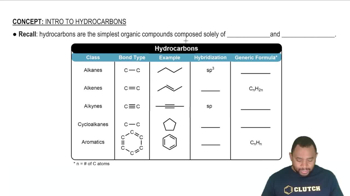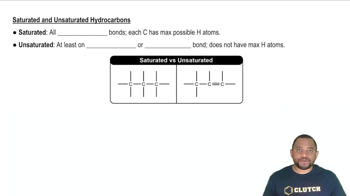Here are the essential concepts you must grasp in order to answer the question correctly.
Hydrocarbon Classification
Hydrocarbons are organic compounds consisting solely of carbon and hydrogen. They are classified into three main categories: alkanes (single bonds), alkenes (at least one double bond), and alkynes (at least one triple bond). The classification is determined by the types of bonds present in the molecular structure, which influences their chemical properties and reactivity.
Recommended video:
General Formula for Hydrocarbons
Each class of hydrocarbons has a general formula that helps identify their structure. Alkanes follow the formula CnH(2n+2), alkenes follow CnH(2n), and alkynes follow CnH(2n-2). By comparing the molecular formula of a compound to these general formulas, one can determine its classification as an alkane, alkene, or alkyne.
Recommended video:
Degree of Unsaturation
The degree of unsaturation indicates the number of rings and multiple bonds in a hydrocarbon. It can be calculated using the formula: Degree of Unsaturation = (2C + 2 + N - H - X)/2, where C is the number of carbons, N is the number of nitrogens, H is the number of hydrogens, and X is the number of halogens. A higher degree of unsaturation suggests the presence of double or triple bonds, which is essential for classifying the compound.
Recommended video:
Saturated and Unsaturated Hydrocarbons
 Verified step by step guidance
Verified step by step guidance


